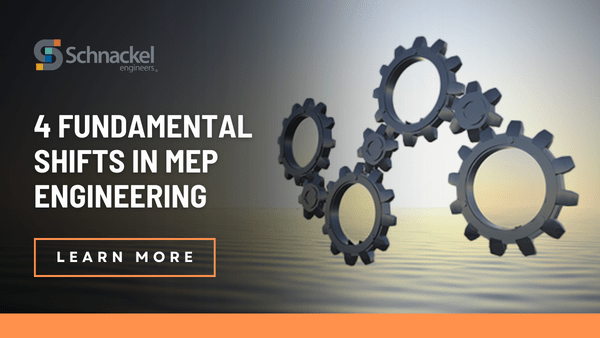4 Fundamental Shifts in MEP Engineering

MEP (Mechanical, Electrical, and Plumbing) engineering plays a crucial role in designing and building modern buildings. The entire construction industry is known to be slow to adapt new technologies. However, over the years, MEP engineering has gone through some significant changes that have transformed building systems. These shifts in MEP engineering have been driven by the need for greater efficiency, sustainability, and automation in modern building systems. In this series of blogs, we will delve into four of the fundamental shifts in MEP engineering that are shaping the future of building systems and their potential impact on the industry and its stakeholders. This initial blog is just an overview of what’s ahead in this series.
Shift #1: Direct Digital Controls vs. Analog Controls
In the past, building systems were controlled by mostly analog systems, even pneumatic, that were limited in functionality and difficult to maintain. However, since the advent of direct digital control systems (DDC) in the late 1980’s, building system controls have undergone a significant transformation. Direct digital controls offer a range of benefits, including remote access, data analysis, and the ability to control multiple systems from a single location. For example, HVAC (Heating, Ventilation, and Air Conditioning) systems can now be remotely controlled and monitored, which allows for more efficient energy usage and better indoor air quality. Digital controls can also provide real-time data on system performance, allowing for more efficient maintenance and repairs.
One of the most significant benefits of digital controls is their ability to reduce energy consumption. Digital control systems can monitor and control building systems more accurately and efficiently, resulting in reduced energy usage and lower utility bills. Furthermore, these systems can be integrated with renewable energy sources like solar panels or wind turbines to reduce reliance on fossil fuels and increase sustainability.
Shift #2: LED Lighting vs. Conventional Lighting
LED (light-emitting diode) lighting has virtually replaced all conventional lighting systems in modern building systems. LED lighting is energy-efficient, has a longer lifespan, and is more environmentally friendly than conventional lighting. LED lighting also offers greater control over lighting levels and colors, which can be used to create different moods and atmospheres in a building. In addition, LED lighting can be integrated with digital control systems to provide greater control and energy savings.
LED lighting has a significant impact on energy usage in buildings. According to the US Department of Energy, LED lighting can reduce energy usage by up to 75% compared to conventional lighting systems. Additionally, LED lighting has a longer lifespan, which reduces the need for frequent replacements and lowers maintenance costs. This makes LED lighting a cost-effective and sustainable choice for modern building systems.
Shift #3: Electric Heating vs. Gas Heating
Modern building systems are transitioning away from gas heating systems toward electric heating systems, often called “electrification”. Electric heating systems offer several benefits over gas heating systems, including improved onsite efficiency, lower maintenance costs, and reduced emissions, depending on the power grid to which they are connected. In addition, electric heating systems are more flexible than gas heating systems and can be integrated with renewable energy sources like solar panels or wind turbines. While gas heating systems have traditionally been less expensive to operate than electric heating systems, the shift towards renewable energy sources and increases in natural gas cost is making electric heating increasingly cost-competitive.
According to the US Environmental Protection Agency (EPA), electric heating produces 35% less carbon emissions than natural gas heating, provided it is connected to a low carbon power grid. This makes electric heating an increasingly viable choice for modern building systems. Electric heat is not without its drawbacks; however, as the US power grid becomes more “green”, electrification will become increasingly popular.
Shift #4: Manual Processes to Automated Processes
One of the most exciting shifts in MEP engineering is the move towards automated processes, driven by advances in technology such as artificial intelligence (AI) and machine learning (ML). AI algorithms can monitor building systems in real-time, collecting data from various sources like sensors, weather forecasts, and building management systems. The data is then analyzed to identify patterns and make real-time adjustments to optimize the system’s performance. For example, AI-powered building automation systems can optimize HVAC and lighting systems to minimize energy usage while maintaining a comfortable indoor environment for occupants.
This automation applies to not only the operation of building systems for improved energy efficiency, but also to the entire design and construction process necessary to construct the building. With the help of AI, manual processes in MEP engineering can be automated, leading to improved efficiency, cost savings, and enhanced safety. By running simulations based on various design scenarios, AI algorithms can help engineers identify the most efficient and cost-effective design solutions. It is clear that AI will play a significant role in the future of MEP design, and those who embrace it early will gain a competitive advantage.
Conclusion
In conclusion, the four fundamental shifts in MEP engineering that will be highlighted in this blog series are transforming the building systems industry. For an industry that is traditionally slow to change, the pace has certainly accelerated, and will continue to do so well into the future.
At Schnackel Engineers, we are at the forefront of the MEP engineering industry, developing the latest technology to provide our clients with innovative solutions that are customized to their unique needs. Our team of experts has the knowledge and expertise to design and implement cutting-edge building systems that are efficient, sustainable, and safe. We integrate AI technology into your MEP design to optimize your building’s construction cost, reduce energy usage, and reduce your time to occupancy. Contact us today to learn more about how we can help you stay ahead of the curve and build a better future for the built environment. Let’s work together to create innovative and sustainable building systems that improve our communities and the world around us.
Comments